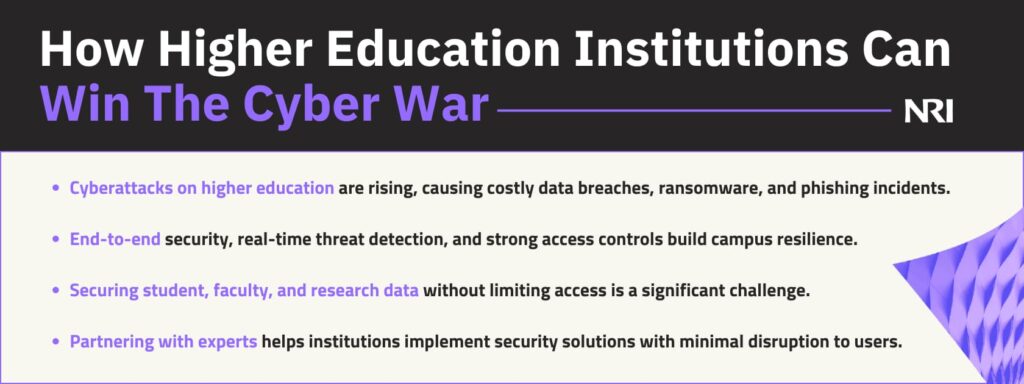攻撃がますます蔓延し、復旧コストが高騰する中、不要なリスクに晒されることなく、積極的な戦略で資産を保護しましょう。

ご存知だろうか。 およそ66 高等教育機関の約66%が2024年にランサムウェア攻撃を経験していることをご存知だろうか。これは、世界全体の平均(59%)よりも7%高い数字です。さらに悪いことに、被害を受けた教育機関は復旧対策に約402万ドル(前年比4倍)を費やしている。
大学は、ランサムウェア、フィッシング、データ流出、その他の攻撃の格好の標的であり続けている。その1つは、価値の高いデータ資産である。ご想像の通り、最先端のAI、医学、工学、その他の大学プロジェクトによる研究は、犯罪者や国家組織にとって非常に有利なものです。学生の財務情報や医療情報も同様に狙われており、1つの記録がダークウェブで200ドル以上の値をつけることもある。
直接的な金銭的インセンティブだけでなく、脆弱な防御、構造的な脆弱性、低いサイバーセキュリティ資金も一役買っている。今日、多くの機関が断片化されたレガシーITシステムをオープンで安全でないネットワーク上で運用しており、ハッカーはたった一度の攻撃でエコシステム全体にアクセスできてしまう。最新のセキュリティ・プログラムと熟練したチームの欠如が、リスクをさらに悪化させている。
高等教育機関はどのようにしてレジリエンスを構築できるのか?この記事では、あなたが知るべきことをすべて取り上げている。続きを読む
高等教育が直面するサイバーセキュリティの主要課題
サイバーセキュリティのベストプラクティスを掘り下げる前に、まずあなたの機関が直面している課題を確認しましょう:
1.膨大な機密データの保護
あなたの組織は、個人を特定できる情報(PII)、財務記録、貴重な知的財産など、膨大な量のデータを扱っていることでしょう。これは2つの問題を引き起こします:サイバー犯罪者の最重要ターゲットになることに加え、学生の入学、卒業、システム内の移動に伴い、データが多様化し、常に変化するため、包括的な監視と保護を維持することは厄介です。
2.分散ネットワークとハイブリッド学習環境におけるセキュリティ管理
ハイブリッド学習環境への移行により、攻撃対象が大幅に拡大しています。ネットワークに接続されたスマートボード、カメラ、研究機器、その他のIoTデバイスだけでなく、学生や教員が寮、喫茶店、サイバーカフェ、さらには異なる地域から分散したキャンパス・ネットワークにアクセスするために使用するデバイスも保護する必要があります。適切な戦略とツールがなければ、これらすべてのエンドポイントを保護することは悪夢となりかねません。
3.アクセシビリティとセキュリティ・コントロールのバランス
学生、教職員、外部パートナーなど、幅広いユーザーがいることも、機密データへのアクセス管理を難しくしている。一方では、権限のない個人を排除するための強固な管理を確立しなければなりません。しかし、これらの対策が厳しすぎてユーザー・エクスペリエンスに摩擦を生じさせてはならない。アクセシビリティとセキュリティのバランスを取ることは、なかなか難しいものです。
レジリエントなキャンパスの作り方
サイバー戦争に勝つための実践的なヒントをいくつか紹介しよう:
1.エンド・ツー・エンドのセキュリティ・ソリューションの導入
今日の巧妙なサイバー犯罪に対する最も効果的な防御策は、ネットワーク、クラウド、エンドポイントのセキュリティを統合することです。これらのソリューションが統合されたシステムとして機能することで、教育機関は妥協することなく規模を拡大し、教職員や学生のニーズに対応することができます。ネットワークのセグメンテーション、アクセス制御、アップグレードの管理、一貫したデータ保護の確保がより簡単になります。同時に、新しいサービス、アプリケーション、プラットフォーム、デバイス(ドアアラームやセキュリティカメラなどの運用技術領域を含む)を含むネットワーク境界の拡張がより効率的になります。
2.リアルタイム脅威検知・対応システムの活用
IT資産を継続的に監視することで、脅威を早期に検知・対応し、被害やダウンタイムを最小限に抑えることができます。これを実現する1つの方法として、高度な人工知能(AI)ツールがネットワーク・トラフィックをリアルタイムで分析し、疑わしいアクティビティ(不正アクセスの試みなど)にフラグを立て、脅威が検出されるとすぐに自動的に対策を発動します。
3.多要素認証(MFA)と暗号化プロトコルの導入
クラウド・サービス、社内ネットワーク、モバイル・アプリケーションなど、すべてのシステムに一貫してMFAを適用することで、資産にセキュリティ層が追加される。ユーザーが知らない場所やデバイスからログインするたびに、複数のステップを踏んで本人確認を行う必要があるため、不正アクセスのリスクが大幅に軽減されます。
データのライフサイクル全体を通じて標準的な暗号化プロトコルを導入することで、関連する復号化キーがなければハッカーがデータを読み取れず、実質的に役に立たないことを保証し、防御をさらに強化することができる。
4.職員・学生を対象とした定期的なサイバーセキュリティ研修の実施
ベライゾンの2024年データ侵害報告書では、セキュリティ侵害の68%に人的要因が関与していると報告されています。強固なセキュリティ・ツールを使用していても、フィッシングやその他のソーシャル・エンジニアリングの手口によって、悪質な行為者が無意識のうちにエンドユーザーを標的にし、組織を侵害する可能性があるということです。
サイバーセキュリティのベストプラクティスに関する意識を高め、ネットワーク、システム、またはデータを危険にさらす可能性のある、クリックすべきでないものをクリックしたり、見当違いの行動をとったりしないようにするためには、定期的なスタッフと生徒のトレーニングが不可欠です。
NRIがセキュリティ態勢の強化をお手伝いします
高等教育機関が激化するサイバー戦争に直面する中、将来を確保するためにはレジリエンスを構築することが不可欠である。これは容易なことではない。幸運なことに、NRIはまさにそれを実践してきた。
当社のセキュリティ・アドバイザリー・チームは、確立された業界のフレームワークを使用して現在のセキュリティ態勢を見直し、ギャップを特定し、望ましい将来の状態に到達するために何が必要かを判断するお手伝いをします。
包括的なリスク・アセスメントと、お客様のニーズに合わせた戦略的ロードマップにより、当社のオペレーション・チームは、お客様独自のリスクと目標に対応する信頼性の高いソリューションを構築、導入、統合します。以下のようなものが含まれます:
- アイデンティティとアクセス制御は、権限のないユーザーをブロックする一方で、重要な資産への許可されたアクセスを保証する。
- エンドポイントセキュリティ、デバイス管理、XDRソリューションにより、すべてのデバイスを継続的に保護します。
- 堅牢なネットワークとクラウドセキュリティ対策により、クラウドとオンプレミスのワークロードを保護します。
- 定期的なシステム・テストでは、実際の攻撃をシミュレートして脆弱性を迅速に特定し、修正する。
- バックアップや冗長化を含むインシデント対応サポートにより、セキュリティイベント時の混乱を最小限に抑えます。
そのため現在では、最新の脅威に対応するために更新され、信頼できるパートナーによって管理されるカスタムセキュリティソリューションによって、職員、生徒、その他の関係者は、安全に重要な教育の優先事項に集中することができます。
御社にふさわしいハイレベルなセキュリティを確立する方法について、今すぐお問い合わせください。



